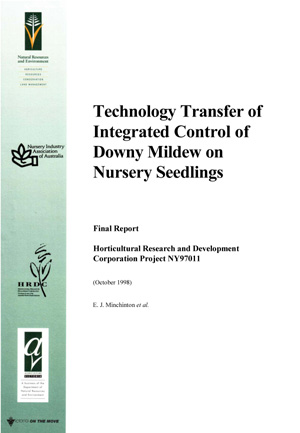|
|
Downy mildew is a major disease of seedlings in nurseries, especially of pansy, brassicas, stock, alyssum, lettuce and poppy and of the shrubs, hebes and roses. I ntegrated management strategies, including fungicide treatments, were developed through two recently completed Horticultural Research and Development Projects (NY97011 and NY9406). The aim of the work reported here was to facilitate the adoption of the research by the nursery industry through a series of seminars, workshops, conferences, nursery visits and various published media. A second part of this project generated data on a phosphonate fungicide, to assist Agrichem Pty Ltd in obtaining registration of the fungicide for use in the nursery industry.
The earlier project (NY9406) identified the fungicide as giving good control of downy mildew on cauliflower and stock seedlings. Six seminars on management of downy mildews in nurseries were delivered at workshops, Annual General Meetings or Conferences, to nurserymen in Western Australia, Tasmania, South Australia, New South Wales (Sydney), New South Wales (Northern Rivers) and Victoria. Several nurseries in each state were visited during the seminar program. Discussions were held with either management or the leading hands on downy mildews in their nurseries and control strategies for the disease. The booklet ‘Downy mildew on nursery plants’ and the seminar handout ‘Downy mildew management in nurseries’ were given to each of the 23 nurseries visited. There was a wide range in the level of downy mildew on nursery seedlings within a state. Some nurseries had major downy mildew problems, some had moderate problems whilst others had no downy mildew diseases. The latter were already using integrated management strategies (environmental management with fungicide protocols) to control the disease. One nurseryman reported that he had changed his watering times and no longer had a downy mildew problem on his seedlings. Another, who grew hebes, improved his hygiene practices, adopted the integrated management strategies and reported that he had controlled the disease on hebes. Downy mildew on lisianthus was identified as an emerging problem in the nursery and cutflower industries. Downy mildew was not detected on pansies in South Australia. The South Australian Research and Development Institute do not have pansies recorded as a host of downy mildew. Consequently, importation of pansy seedlings into South Australia from other states should be viewed with concern for fear of introducing the pansy downy mildew disease into the state. A systemic phosphonate fungicide was trialed as a fortnightly drench treatment on cauliflower, pansy and stock seedlings and on potted roses against the standard mancozeb treatment applied weekly. The phosphonate treatment was as effective or better than the mancozeb treatment depending on disease pressure. When disease pressure was high a combination of both phosphonate and mancozeb gave better control than either treatment alone. The phosphonate treatment was phytotoxic when applied as a drench to the potted roses but not when applied as a spray to rose cuttings. The data from these trials is being used by Agrichem Pty. Ltd. to obtain registration of the fungicide as a downy mildew control through the National Registration Authority. A review of blue igloo film cover, indicates that in some parts of Australia, it may have potential to reduce the impact of downy mildew diseases. Recommendations :
Acknowledgements : The authors thank the Nursery Industry Association of Australian, the Horticultural Research and Development Corporation and Agriculture Victoria for financially supporting the project. The Nursery Industry Association of NSW, the Nursery and Landscape Industry Association of South Australia, the Nursery Industry Association of Western Australia, the Nursery Industry Association of Tasmania, the Nursery Industry Association of Victoria and the Queensland Nursery Industry Association are thanked for their support of the project. The authors thank the industry development officers Ian Atkinson, Anne Frodsham (SA), Richard Stephens (NSW), Sandy Pate (WA), John McDonald (Qld) and Greg King (Vic), the state secretary Colin Fleming (Tas), the NIAA training officer Greg McPhee, Denis Cook the secretary of the Northern Rivers Branch of NIA of NSW, Chris Douglas president of the Tree and Shrub Growers Association of NSW, Des Leeke of the Tube Growers Association and Domenic Cavallaro Horticultural Consultant for the opportunity to present results of the project to industry and for assistance with organising nursery visits. Nursery management and staff at the various nurseries visited during the project are thanked for making the time available to discuss downy mildew in their nurseries. Also scientists visited during the project are thanked for their helpful discussion. |
||||||
|

